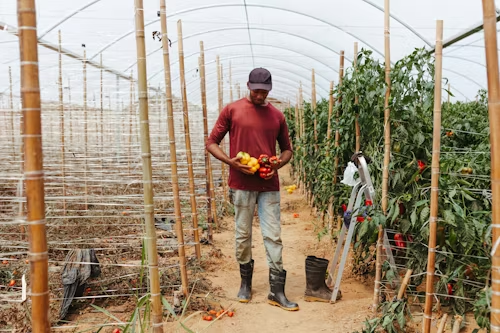Introduction
Agribusiness is a cornerstone of Africa's economy, employing millions and contributing significantly to GDP in many countries. With the rising demand for food, exports, and agricultural innovations, there has never been a better time to venture into this industry. This guide provides an exhaustive roadmap to help you establish and grow a successful agribusiness in Africa.
Step 1: Research and Identify Your Niche
Agriculture encompasses various sectors. Choosing a niche allows you to focus on specific opportunities and challenges. Here are some popular niches to consider:
Crop Farming: Maize, cassava, rice, avocados, or cash crops like coffee and cocoa.
Livestock Farming: Poultry, cattle, goats, or aquaculture (fish farming).
Agro-Processing: Adding value to raw materials, such as producing cassava flour or packaged fruit juices.
Agri-Tech: Offering digital platforms or devices to improve farming efficiency.
Export Crops: Growing high-value crops like tea, flowers, or organic produce for international markets.
Agroforestry: Combining agriculture with forestry to maximize land use and sustainability.
Conduct thorough research on market demand, climate suitability, and potential competitors before settling on a niche.
Step 2: Create a Business Plan
A well-thought-out business plan is crucial for success. Your plan should include:
Mission and Vision: Define your goals and long-term aspirations.
Market Analysis: Identify your target market and competitors.
Financial Plan: Budget for startup costs, operational expenses, and potential revenue.
Operational Plan: Detail the day-to-day activities, such as planting schedules, harvesting, and distribution.
Risk Assessment: Outline possible risks like pests, weather changes, and market fluctuations, along with mitigation strategies.
Step 3: Acquire Land and Necessary Resources
Choosing the Right Land: Ensure the land is suitable for your chosen niche. For example, rice farming requires waterlogged areas, while maize thrives in well-drained soils.
Access to Resources: Secure high-quality seeds, fertilizers, and farming equipment. Explore options like renting machinery if purchasing is too costly.
Water and Irrigation: Ensure access to water through boreholes, rivers, or irrigation systems. Consider drip irrigation for efficient water use.
Step 4: Secure Funding
Starting an agribusiness can be capital-intensive. Here are funding options to explore:
Personal Savings: Ideal for small-scale startups.
Government Grants: Many African governments offer grants for agricultural initiatives.
Microfinance Loans: Accessible to small farmers and startups.
Investors: Attract angel investors or venture capital by presenting a solid business plan.
Agricultural Co-operatives: Join groups that provide funding and resources to members.
NGOs and Development Agencies: Organizations like USAID and the World Bank often fund agribusiness projects.
Step 5: Build Expertise and Partnerships
Training and Skills Development: Attend workshops and training sessions on modern farming techniques. Learn about sustainable practices to maximize yield and reduce environmental impact.
Networking: Join farmer associations or agribusiness forums to connect with peers and experts. Partner with local and international buyers to secure markets for your produce.
Step 6: Start Small and Scale Gradually
Starting small allows you to manage risks while learning the nuances of your business. Focus on perfecting your processes before expanding. For instance:
Begin with a few acres of land.
Test different crop varieties or livestock breeds.
Experiment with marketing channels to find the most effective strategies.
As you gain experience, reinvest profits to scale up operations.
Step 7: Leverage Technology and Innovation
Agri-tech is transforming agriculture in Africa. Adopt technology to improve efficiency and competitiveness:
Farm Management Apps: Use apps like FarmLogs to monitor crop health and yield.
Drones: For aerial surveillance and pest control.
Automated Irrigation: Saves water and ensures consistent crop growth.
E-commerce Platforms: Sell produce online to reach a broader market.
Step 8: Focus on Marketing and Distribution
Local Markets: Supply fresh produce to local shops, supermarkets, and open markets.
Export Opportunities: Explore international markets for high-value crops.
Agro-Processing Partnerships: Sell raw materials to processors for added income.
Branding: Develop a unique brand to stand out, especially for organic or premium products.
Step 9: Monitor, Evaluate, and Adapt
Track Performance: Regularly assess your yield, sales, and profit margins.
Adapt to Trends: Stay updated on agricultural trends, such as demand for organic produce or climate-resilient crops.
Seek Feedback: Learn from customers and partners to improve your offerings.
Challenges in Agribusiness
Climate Change: Unpredictable weather can affect yields. Invest in climate-resilient crops and technology.
Pests and Diseases: Use integrated pest management (IPM) to reduce losses.
Market Access: Build relationships with buyers and explore alternative sales channels.
High Startup Costs: Start small and leverage grants and loans.
Conclusion
Starting an agribusiness in Africa is a rewarding venture with immense potential. By choosing the right niche, leveraging technology, and building strong partnerships, you can establish a sustainable and profitable business. Remember to start small, adapt to challenges, and reinvest in growth. With determination and the right strategy, your agribusiness can thrive in Africa's vibrant agricultural landscape.
